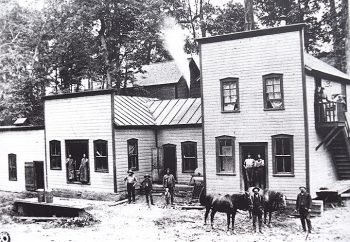
Butter was a staple for the early settlers of southeast Minnesota. Before cooking oil, there was lard and butter for cooking and baking. Butter was on every dinner table for use with many foods. However, butter did not become a major commercial enterprise until dairying became a major agricultural pursuit in the 1880s. Raising hogs was the first large-scale livestock operation in Houston County, followed by dairying. Some of the acreage too steep for agriculture, previously used for harvesting hardwood, was grubbed for additional pastures for herds of dairy and beef cattle.
Some early creameries were private businesses, including the 1888 Crystal Spring Creamery in Wilmington and Polar Creamery in Houston. Farmers soon established co-op creameries in almost every burg. The first co-op in far southeastern Minnesota was Honey (Bee) Creamery in Bee, built in 1894. Among other co-ops organized were: Wilmington in 1901, Houston probably 1902, Yucatan 1906 and Caledonia 1910.
Houston’s new 1920s brick creamery building was located close to the railroad tracks, because some trains picked up cans of cream along the way. Farmers built platforms next to the tracks, so the baggage car attendant could easily load cream cans. Because these “milk trains” or trains making “milk runs,” made so many stops, they were avoided by passengers desiring speedier travel.

Photo submitted
Farmers used a cream separator, a machine usually referred to as “a separator” to separate skim milk and cream. The cream could be churned into butter, while skim milk was for drinking or feeding livestock. Cream could always be churned into butter on the farm, a labor-intensive chore. After creameries were established, it was more convenient to purchase butter from the local creamery.
To prevent cream becoming sour, it needed to kept cool until it was taken to a creamery. Before refrigeration became available in the 1940s, cream cans were often lowered by rope or chain into a well-water or rainwater cistern. In a rainwater cistern, a heavy rain might raise the water level and cause cans to tip over, soiling water and cream.
Farmers near a creamery might sacrifice time to haul his cream to the creamery. But most used self-employed cream haulers, who would pick up cream from several farms about three times a week. The haulers were usually farmers, too, the earliest driving horse-drawn wagons carrying several 30-gallon vats, known as cream cans.
Those early haulers also sampled and tested cream for amount of butterfat, a procedure that in later years was performed at the creamery instead. Haulers could also deliver cleansers for the farmer’s separator. Cleaning was more work than separating.
There needed to be enough haulers to complete the routes on schedule. Cream needed to arrive at the Spring Grove Creamery by noon if it was to be ready for churning the following morning. In the afternoon, there would weighing, testing for the amount of butter fat and pasteurizing before cooling overnight.
The haulers were paid by the creamery, but the cost was deducted from what was paid to the farmer for his cream. Cream checks were issued every two weeks.
The churning at the creamery produced butter as well as buttermilk, a byproduct. The farmer could buy what butter was needed for family use and buttermilk to feed the pigs. The purchase would be deducted from the family’s cream check. In Wilmington, butter could be purchased any day, but each farmer had a certain day of the week when he was scheduled to pick up his contracted amount of buttermilk. He would drive to the creamery with his wagon and empty milk cans.
In the 1940s and 1950s, there were five grocery stores in Spring Grove that stocked butter for local customers. The creamery turned out 900 pounds of butter each week for local consumption. Each pound would be wrapped individually by hand. But most profit came from selling butter to regional wholesalers. At first, butter was packed for shipping in round wooden tubs with wooden covers. Later, 50-pound cardboard boxes were more convenient. Both Wilmington and shipped butter to Chicago. Some butter from Bee was shipped to Philadelphia. Butter from Bee won first prize at the National Butter Makers Convention in 1900.
Sources: Retired butter maker Paul Engene, farmer Glenn Kinneberg, the research of Jan Lee Buxengard and the archival clippings of several area newspapers.


Leave a Reply